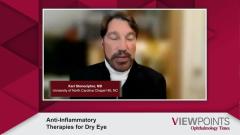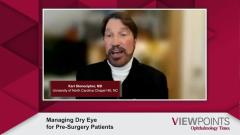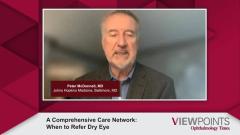
Dry Eye as Comorbidity
Expert panelists discuss the co-occurrence of dry eye disease with other ocular comorbidities and highlight the frequently observed concurrent ocular conditions.
Episodes in this series

Marguerite McDonald, MD, FACS: Hello, and welcome to this Ophthalmology Times Viewpoints entitled, Enhancing Dry Eye Care for Patients with Ocular Comorbidities. I'm Marguerite McDonald. I'm a clinical professor of ophthalmology at both NYU and Tulane and a cornea, cataract, refractive surgeon on Long Island with Oakley Vision. I'm joined by 2 colleagues who are literally household names. And I'm going to ask them to introduce themselves. In alphabetical order, Dr. Peter McDonnell, please introduce yourself.
Peter McDonnell, MD: Hi, I'm Peter McDonnell. I'm the William Holland Wilmer Professor and Chairman at the Wilmer Eye Institute in Baltimore. And I'm also a cornea and refractive surgery training specialist.
Marguerite McDonald, MD, FACS: Thank you. And Dr. Karl Stonecipher.
Karl Stonecipher, MD: Hey, great to see you again, Marguerite. I'm Dr. Karl Stonecipher. I'm a clinical professor of ophthalmology at the University of North Carolina. And I'm also a clinical adjunct professor of ophthalmology at Tulane University. So I get to work a lot with the residents. And then in my private practice, I'm medical director of laser-defined vision, Physician's Protocol Research, and Physician's Protocol Cosmetics. And I do cornea, cataract and refractive, as well.
Marguerite McDonald, MD, FACS: Great, thank you. Today's conversation is going to center on the management of dry eye in the presence of concurrent ocular conditions, as well as managing dry eye prior to undergoing any cataract or refractive surgery. So welcome and let's get started. We're going to talk about dry eye as a comorbidity for a few minutes. And I'll start with you, Karl, if you don't mind. How frequently do you encounter dry eye as a comorbidity in patients who present with other ocular issues? And what are the most common concurrent conditions they present for?
Karl Stonecipher, MD: It's a great question because the practices [may] vary. And all of us are cornea and cataract and refractive surgeons in terms of the big picture. So, on my refractive surgery side, it's a little bit higher. I would probably say if I'm not seeing 1 and 3 of my patients that have some type of dry eye comorbidity, I'm missing it. And then on the cataract side, for sure, it was probably 1 and 5, at least 1 and 4. I know Marguerite, you and I were on the PHACO dry study and that one, it was about 1 and 5. I think that if I'm looking at a general ophthalmologist or optometrist, I'm looking at him and saying, if you're not finding some type of comorbidity of a dry eye in at least 20% of your patient population, I don't think you're looking hard enough. Peter?
Peter McDonnell, MD: You know, Karl, it's gotten to the point where sometimes I think everybody has dry eye until proven otherwise, particularly in the older patient population. In a number of papers, 80% of patients on chronic glaucoma therapy and glaucoma clinics have moderate to severe dry eye by these standard questionnaires. And just as you said, cataract 25 to 50%, the American Academy of Ophthalmology says, and maybe refractive surgery, it's somewhat less because they're younger. But, boy, when it causes problems, post-op could really result in frustration. So I've come to the stage in my career where I basically look at every patient with the goal of ruling it out because it just is so common. I want to make sure that I don't miss it.
Marguerite McDonald, MD, FACS: We know we find it when they come in for cataract surgery. And I agree dry eye is obviously less common in younger people, but with the LASIK population, they have selected themselves out, the dry eye patients, because they've flunked out of their contacts due to dry eye and they're showing up and also a high percentage of our cases. Would you agree, Karl?
Karl Stonecipher, MD: I totally agree and I think like Peter does. I look forward to everybody. I don't care whether you're 8 or 10 [years old], in a pediatric population, Preeya Gupta has done a lot of studies to show us that it's becoming more prevalent in that group. But I think that, for me, it's kind of hard to miss dry eye and then explain it away. We're screening pretty much the majority of our population, if not everyone for dry disease, whether you're a cataract candidate or you're a refractive candidate, or even the glaucoma population, as Peter mentioned.
Marguerite McDonald, MD, FACS: If I may depend for just a second, I was just going to say, I find lagophthalmos with exposure keratitis is incredibly common and ocular allergies. When they have ocular allergies and dry eye, they can't wash out the pollen, and so the 2 separate diagnoses aggravate each other. How about you, Peter?
Peter McDonnell, MD: Yeah, absolutely. And sometimes you'll see interesting things where you're talking to the patient in the exam chair and the patient's not blinking. And it's because they either have undiagnosed or maybe it's diagnosed Parkinson's disease and their blink rate goes way down. And of course, lid margin disease, blepharitis, other conditions that can contribute to ocular surface disease and meibomian gland dysfunction, loss of mucin, and lipid layer of the tear film. So it's one of those things where I think to spend a few minutes talking to the patient, get the history, see if they have any symptoms, and then do the full eye exam, even if they present specifically because there are -4 and they want that addressed. We don't want to skip over looking for this very important problem.
Marguerite McDonald, MD, FACS: That's an excellent point, Peter. And the Mike Lemp paper, the famous Lemp paper documented that 86% of dry eye patients have meibomian gland disease. And Kelly Nichols a few years later found that 92%. They are truly 2 sides of the same coin actually.
Transcript is AI-generated and edited for clarity and readability.
Newsletter
Don’t miss out—get Ophthalmology Times updates on the latest clinical advancements and expert interviews, straight to your inbox.






















































